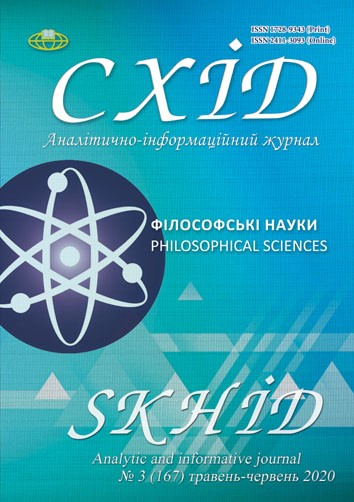Concepts of Asia in Japanese Pan-Asianism: from cultural to religious and political borders
DOI:
https://doi.org/10.21847/1728-9343.2020.3(167).206674Keywords:
Pan-Asianism, the concept of “Asia”, the concept “the West”, the concept “the East”, “Hakko Ichiu”, Western imperialism, “sangoku”Abstract
Pan-Asianism in Japan arose as a reaction against the imperialist policy of the West. Throughout the development of Pan-Asianism in Japan, one of the central issues for its followers was the definition of the criteria of “Asianness”; and questioning the boundaries of a new meta-geographical space - Asia. The article is devoted to the issue of the variations of the view on Asia within the Japanese Pan-Asianism of the II half of the XIX-XX centuries. The classification of Asian concepts according to the criterions of “Asianness” is derived. By using the methodology of discourse analysis, the article provides a detailed analysis of the development of these criteria in different contexts of Japanese culture, politics and religion. An analysis of the historical development of the vision of Asia in Japan allowed us to establish the bond between the evolution of views on Asia and the specifics of Pan-Asianism in general. The article also provides an analysis of the sources and history of the term “Asia” in Japan. The central importance of this concept for the phenomenon of pan-Asianism is proved as the result of the study. The study could be seen as the first comprehensive examination of Japanese pan-Asianism in terms of views on a meta-geographical space which was new to Japan- Asia. The study of this issue in modern Japanese studies is developing in the direction of analysing the historical, economic and political significance of Pan-Asianism, the concepts of Asia and its individual countries in Japan. A detailed examination of the historical formation of the concept of "Asia" in Japan will help to upgrade both the understating of Pan-Asianism and the modern specific of view on the features of "Asian" or "Eastern" civilizations. The presented study offers a broader view of one of the central issues of Japanese pan-Asianism in general.Downloads
References
Bialock, David T. (2007). Eccentric Spaces, Hidden Histories: Narrative, Ritual, and Royal Authority from The Chronicles of Japan to The Tale of the Heike. Stanford University Press, 488 p.
Brandenburg, U. (2018). The Multiple Publics of a Transnational Activist: Abdurresid Ibrahim, Pan-Asianism, and the Creation of Islam in Japan. Welt Des Islams, 58(2), 143-172. DOI: https://doi.org/10.1163/15700607-00582p01
Hoon, C. Y. (2004). Revising the “Asian Values” Argument Used by Asian Political Leaders and Its Validity. Research Collection School of Social Sciences. Singapore Management University, p. 154-174.
Szpilman, Ch. W. A. & Saaler, S. (2011). Pan-Asianism as an Ideal of Asian Identity and Solidarity, 1850-Present. The Asia-Pacific Journal. Retrieved from https://apjjf.org/-Sven-Saaler--Christopher-W--A--Szpilman/3519/article.pdf
Duara, P. (2001). The discourse of civilization and Pan-Asianism. Journal of World History, 12(1), 99-130. DOI: https://doi.org/10.1353/jwh.2001.0009
Eri, Hotta (2007). Pan-Asianism and Japan’s Was 1931-1945. New York: Palgrave Macmillan, 290 p.
Iguchi, G. S. (2006). Nicherenism as Modernism: Imperialism, Fascism, and Buddhism in Modern Japan. San Diego: University of California, 328 p.
Katzenstain, Peter J. (1996). Introduction: Asian Regionalism in Comparative Perspective. In: Network Power. Japan and Asia. Ithaca; London: Corell University Press, pp. 1-44.
Brij, Tankha (2007). Okakura Tenshin and Pan-Asianism: Shadows of the Past. New Delhi: Sampark, 189 p.
Peattie, M. R. (2008). Pan-Asianism in modern Japanese history: Colonialism, regionalism and borders. Pacific Affairs, 81(2), 285-287.
Saaler, S. (2007). The construction of regionalism in modern Japan: Kodera Kenkichi and his "Treatise on Greater Asianism" (1916). Modern Asian Studies, 41, 1261-1294. DOI: https://doi.org/10.1017/s0026749x06002605
Saaler, S., Koschmann, J. V. (2008). Pan-Asianism in Modern Japanese History: Colonialism, Regionalism, and Borders (vol. 11, pg 288, 2006). Social Science Japan Journal, 11(2), 369-369. DOI: https://doi.org/10.1093/ssjj/jyn028
Krämer, Hans Martin (2014). Pan-Asianism's Religious Undercurrents: The Reception of Islam and Translation of the Qur'ān in Twentieth Century Japan. The Journal of Asian Studies. P. 619-640. Retrieved from http://journals.cambridge.org/abstract_S0021911814000989
Towards an East Asian Community: Region of Peace, Prosperity and Progress (2001). East Asian Vision Group Report. Retrieved from http://www.asean.org/archive/pdf/east_asia_vision.pdf
Collection of works of Ippei Tanaka. 一平田中全種、1巻。東京 - 特色大学、2002年 - 385 ページ
Kytay ochyma Aziyi (2017). Instytut skhodoznavstva im. A. YU. Krymskoho NAN Ukrayiny, Ukrayinska asotsiatsiya kytayeznavtsiv. Kyiv, 316 s. (In Ukrainian)
Shimamoto, Takamitsu, 嶋本,隆光 (2008). Okawa Shumei' Religious Studies. The road to Islamic studies. 大川周明の宗教研究一イスラーム研究への道一. University of Osaka大阪大学, 22 p.
Collection of works of Ishiwara Kanji. 石原莞爾全集。全8巻、東京:石原莞爾全集刊行会、1976-1977年
Downloads
Published
How to Cite
Issue
Section
License
Copyright (c) 2020 Oleksandra Bibik

This work is licensed under a Creative Commons Attribution-NonCommercial-NoDerivatives 4.0 International License.
1. Authors bear responsibility for the accuracy of facts, quotations, numbers and names used.
2. Manuscripts are not sent back.
3. The publisher does not always agree with the authors' opinion.
4. The authors reserve the right to authorship of the work and pass the first publication right of this work to the journal under the terms of a Creative Commons Attribution-NonCommercial-NoDerivatives 4.0 International License. This license allows others to distribute (copy) the published work for non-commercial purposes, provided there is mandatory attribution to its authors and a link to the first publication in our journal.
5. The authors have the right to conclude separate supplement agreements that relate to non-exclusive work distribution in the form in which it has been published by the journal (for example, to upload the work to the online storage of the journal or publish it as part of a monograph), provided that the reference to the first publication of the work in this journal is included.

